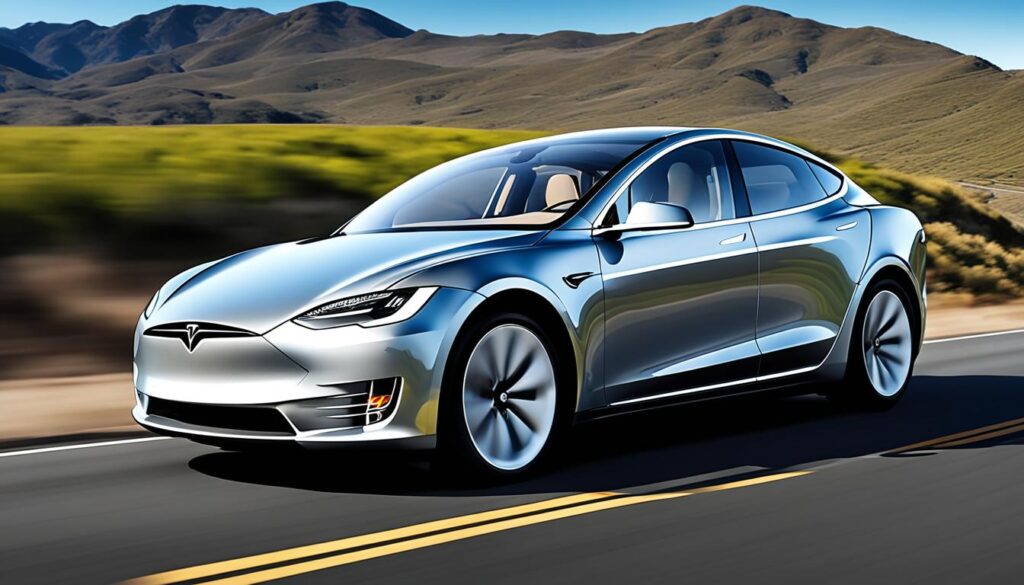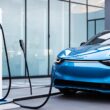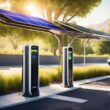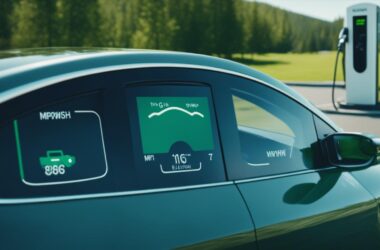I love cars and care a lot about our planet. I find Tesla’s use of electricity instead of petrol very interesting. Knowing about tesla miles per kWh shows how well Tesla does in saving energy. It also shows a big change in how we think about car fuel. Every year, Tesla makes better electric cars. This helps our planet by using less energy. So, learning about how energy consumption Tesla models use is very important. It helps us choose better cars and be smarter about energy.
Key Takeaways
- Tesla’s miles per kWh metric is an accurate measure of electric vehicle efficiency.
- Understanding kWh usage is crucial in determining the range and performance of your electric car.
- Comparing Tesla’s energy efficiency with conventional vehicles showcases the benefits of electric propulsion.
- Grasping this concept aids in appreciating Tesla’s technological advancements in reducing energy consumption.
- Awareness of Tesla’s efficiency can influence more sustainable vehicle choices amongst consumers.
Decoding the Miles per kWh Metric in Electric Vehicles
The world of cars is changing, moving towards being green. Phrases like electric car range, Tesla Model S efficiency, EV battery efficiency, and energy efficiency electric vehicles are important. They tell us how well and economically electric cars work.
Defining Miles per kWh for Tesla and Other EVs
Miles per kWh is a key number. It shows how far an electric car can go on one kilowatt-hour. Tesla shows this to highlight the Tesla Model S’s top performance. This helps people think about how much money they could save by using less petrol.
Calculating Efficiency: The Importance of kWh in Your Electric Car’s Range
Looking at an EV’s battery kWh tells us a lot. It shows us how far the car might go. Cars with more kWh can usually go further. This is true if the car’s battery works well.

Comparing EVs and Traditional Vehicles: MPG vs. Miles per kWh
Moving to miles per kWh changes how we talk about car energy. It shows the leap from old tech to new. Electricity as fuel changes how we see car travel and efficiency.
| Measurement | EVs | Traditional Vehicles |
|---|---|---|
| Unit of Energy | kilowatt-hour (kWh) | Gallon of Petrol |
| Efficiency Metric | Miles per kWh | Miles per Gallon (MPG) |
| Cost Effectiveness | Higher (Varies on electricity tariffs) | Lower (Dependent on fuel prices) |
| Environmental Impact | Lower carbon footprint | Higher emissions |
The data shows us a big difference. Evaluating EVs like the Tesla Model S uses new metrics. Looking at miles per kWh brings a modern, eco-friendly view.
Breaking Down Tesla’s kWh Mileage: How Efficient Is Your Tesla?
People love green transport and tech wonders. They often ask me about Tesla’s kWh per mile. This is key for knowing how well these cars do. It tells us about their range and how much energy they use.
Tesla shows how much energy their cars use. Let’s look at different Tesla models and their energy needs. The Model S has great range and zips fast. It uses energy well, which is cool. The Model 3 and Model X are also top-notch in using energy wisely.

Tesla’s special because of its electric engines and smart power use. They are fast but still keep energy use low for long trips.
Teslas use power wisely, for many years. They mix speed with saving energy. This way, they go far without wasting energy per mile.
Let’s check out Tesla models and their energy use:
| Model | kWh Per Mile | Estimated Range |
|---|---|---|
| Model S | 0.28 | 405 miles |
| Model 3 | 0.26 | 353 miles |
| Model X | 0.35 | 340 miles |
| Model Y | 0.28 | 326 miles |
Every Tesla is different in how efficient it is. Looking at your Tesla’s kWh per mile can show how things like driving style affect its use.
Tech, speed, and saving power make Tesla lead in electric cars. Knowing your car’s kWh per mile helps use it best. It makes driving a Tesla an amazing experience.
Factors Influencing Tesla Miles per kWh
Knowing what affects your Tesla’s efficiency can help a lot. It makes the battery last longer and uses energy better. There are many things that can change how much power your electric car uses. Let’s look at the main points to use less energy, save money, and help the planet.
The Impact of Weather on Electric Vehicle Efficiency
Weather is very important for electric vehicle efficiency. It affects how much energy a Tesla uses. Cold weather makes the battery work less well. This means you get fewer miles for each kWh because it uses more energy to keep warm. Hot weather also uses more energy for cooling. It can also make the battery get old faster.
Driving Habits and Their Effects on EV Battery Efficiency
How you drive makes a big difference to your EV battery efficiency. Driving fast and hard can use up the battery quickly. Driving gently and slowly helps the battery last longer. It also gives you more miles for each kWh. Keeping your car well-maintained and driving wisely improves energy use a lot.
Optimising Your Tesla’s Energy Consumption for Better Mileage
To make your Tesla go further, try these tips:
- Use regenerative braking to get some energy back
- Keep a steady speed and use cruise control if you can
- Try not to use the heater or air conditioner too much
- Charge your car when electricity is cheaper, usually at night
- Make sure your tires are pumped up right to use less energy
Understanding these points and optimising Tesla energy consumption makes for a better drive. It saves money and is kinder to the Earth. Knowing about the weather, how you drive, and how to make your car more efficient helps a lot. It keeps your Tesla’s battery working well and improves how it runs.
| Factor | Impact on EV Efficiency | Optimisation Tips |
|---|---|---|
| Cold Weather | Decreases range | Pre-heat while plugged in |
| Hot Weather | Increases battery strain | Park in the shade to minimise cooling system use |
| Driving Habits | Can reduce or enhance efficiency | Adopt smooth driving techniques |
| Vehicle Maintenance | Ensures efficiency is upheld | Regularly service vehicle |
| Tire Pressure | Affects rolling resistance | Check and adjust tire pressure monthly |
Conclusion
I’ve been exploring how electric vehicle efficiency works. Mainly, I looked at Tesla miles per kWh. This shows us how much energy Tesla cars use. Teslas are not just cars. They are examples of great inventions and efficiency. They show us how far car technology has come.
We saw that Tesla sets high standards in efficiency with their miles per kWh. This isn’t just about how far a car can go or how much energy it uses. It’s a story about Tesla wanting to make traveling better and greener. I hope my research helps you understand electric cars better. So you can choose the right one.
Tesla’s cars show us how eco-friendly travel is getting better. I want to highlight the importance of these amazing cars. They help us use energy in a smarter way for our planet. Learning about Tesla’s efficiency is more than just numbers. It’s about making travel better for our future.











What i don’t understood is in fact how you are no longer actually much more well-appreciated than you might be right now. You are so intelligent. You already know thus considerably in terms of this topic, produced me in my view consider it from a lot of numerous angles. Its like men and women are not involved until it is something to do with Lady gaga! Your own stuffs nice. At all times deal with it up!
This is a very good tips especially to those new to blogosphere, brief and accurate information… Thanks for sharing this one. A must read article.
I was suggested this blog by my cousin. I am not sure whether this post is written by him as nobody else know such detailed about my difficulty. You are amazing! Thanks!
Good day very nice blog!! Guy .. Excellent .. Amazing .. I will bookmark your web site and take the feeds also…I’m happy to search out numerous useful information here in the put up, we’d like develop extra strategies on this regard, thank you for sharing. . . . . .
Way cool, some valid points! I appreciate you making this article available, the rest of the site is also high quality. Have a fun.
I happen to be writing to make you understand what a excellent discovery my girl experienced viewing your webblog. She came to find many issues, which include what it is like to have an amazing coaching character to get folks really easily have an understanding of a variety of problematic things. You really did more than my expectations. Many thanks for delivering these great, safe, edifying and also unique tips about the topic to Tanya.